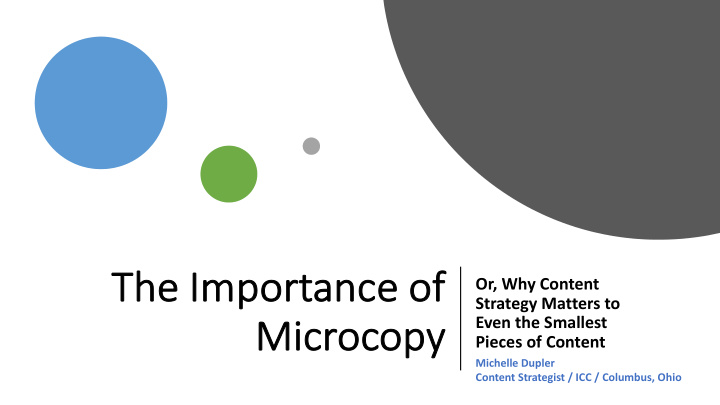



The Importance ce of Or, Why Content Strategy Matters to Micr crocopy Even the Smallest Pieces of Content Michelle Dupler Content Strategist / ICC / Columbus, Ohio
A Tale of Two Doormats
A Tale of Two Doormats
A Tale of Two Doormats Think about the different messaging these two doormats each convey with just one word. • What does “Welcome” communicate? • What does “Leave” communicate?
More Doormats: The Nice
More Doormats: The Naughty
More Doormats: The Nerdy
What do all of these doormats have in common?
Content
Now imagine that these doormats are buttons or labels on your website or app. Are they communicating the ideas or feelings you want your user to experience?
Microcopy is a small piece of written copy that helps a user perform a task or understand context. It can be: • A word • A phrase • A short sentence What is Microcopy? • Button text • Navigation labels • Error messages • Alerts • Instructions or Explainers • Hints
Microcopy is Important Because It helps users perform tasks
How many times have you tried to create an account on a website and gotten an error message? But the error message doesn’t tell you what’s actually wrong? Does the username need Is the password in the to be an email? wrong format? You have no idea. Then someone has to write an FAQ and you have to search the Help or Support topics and probably not find what you’re looking for anyway.
Example: Mail Chimp • This example from Mail Chimp tells you exactly what’s wrong. “Sorry, we couldn’t find your username.” Or “Sorry, that password isn’t right.” And then offers to help you recover the information. • The microcopy tells the user why they’re experiencing an error and offers a solution to the problem.
Microcopy is Important Because It sets users’ expectations
Example: InVision Enterprise Sign-Up At the end of the signup process, the microcopy concisely communicates the expectation that the user will receive an email with further instructions — and does it in a conversational way.
Example: Dollar Shave Club This is from their homepage. With just a handful of words, they’re telling users what they’ll get. The button microcopy is a nice, conversational imperative.
Example: Intercom This is a nice example of how to use microcopy to communicate expectations in a video link. By telling the user how long the video is, you’re giving useful information that helps them decide if they want to consume the content.
Microcopy is Important Because It reassures users
Example: Simple Steps Code This piece of microcopy concisely reassures the user that when they request the JavaScript road map, they won’t also be signing up for spam. No one likes spam. Except Monty Python.
Microcopy is Important Because It helps drive conversions
Veeam had this language on a product page. Seems Ca Case St Study: y: legit, right? But in an on-page survey, they noticed Ve Veeam that a lot of users were asking for a price, not a quote.
Ca Case St Study: y: So they changed one word in their microcopy and Ve Veeam tested it.
Ca Case St Study: Ve Veeam A one-word change from “quote” to “pricing” in the link text resulted in a 161.66 percent increase in clicks .
Clear Good Informative Microcopy Helpful Should Be Written in your users’ language
Microcopy = Content The Role of (even if it’s just one word) Content Strategy Content = Content Strategy
The Role of Content Strategy So what In a is content nutshell, strategy? planning.
The Role of Content Strategy “Planning for the creation, delivery, and governance of useful, usable content” — Kristina Halvorson “A content strategy is the high-level vision that guides future content development to deliver against a specific business objective.” — Hannah Smith, Distilled
The Role of Content Strategy Content Perform qualitative content audits to identify where existing content can be improved or where there opportunities for content to meet business needs Strategists Interpret analytics to determine how users consume or interact with content may: Perform competitive research and analysis Talk to businesses / clients to help identify how content can meet their needs and goals Work with UX researchers and designers to identify user needs and how content can meet those needs
The Role of Content Strategy Content The big picture of your content Strategy What the content will be — what types plans for: How the content works together to inform or guide user experience The structure of content across your project (often overlaps with information architecture)
That’s all just as true for microcopy. You need to: Document it Plan for how the (e.g., which pages need microcopy fits into Know your audience error messages, what’s overall user experience the common lexicon for microcopy)
Ke Key Takeaways • Content is all around you (even on doormats) • Good content takes planning, even the tiny bits • If you have access to content strategists on your team, talk to them! They’re usually nice people, although they might be a little weird sometimes.
Some fun reading for your copious free time. OK. Maybe relevant is a better word than fun. Content Strategy for the Web, Second Edition, Kristina Halvorson http://a.co/d/bJpbLkL The Content Strategy Toolkit: Methods, Guidelines, and Templates for Getting Content Right, Meghan Casey http://a.co/d/j8EaPhO Microcopy: Discover How Tiny Bits of Text Make Tasty Apps and Websites, Niaw de Leon http://a.co/d/5ERdnOx Microstyle: The Art of Writing Little, Christopher Johnson http://a.co/d/3tJD5Pt You've Got 8 Seconds: Communication Secrets for a Distracted World, Paul Hellman http://a.co/d/gHzGcNE
Connect With Me Hit me up with questions after the con! Let’s talk content strategy. Michelle Dupler mdupler@meetclutch.com https://www.linkedin.com/in/ michelle-dupler/
Recommend
More recommend